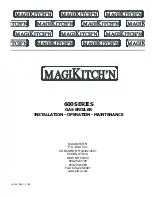
Installation & Operation Manual
34
6
Hydronic piping
Near boiler piping components
1.
Boiler system piping:
Boiler system piping MUST be sized per the pipe
requirements listed in Table 6A. Reducing the pipe size
can restrict the flow rate through the boiler, causing
inadvertent high limit shutdowns and poor system
performance. Flow rates are based on 20 feet of piping,
4 - 90° elbows, and 2 - fully ported ball valves.
2.
Boiler circulating pump:
A Grundfos UPS26-99F pump will be provided by the
factory (for standard altitude models) as the boiler
circulation pump based on 20 feet of piping, 4 - 90°
elbows, and 2 - fully ported ball valves.
Knight wall mount boilers are capable of controlling a
variable speed boiler circulator. Variable speed
circulators MUST be sized to meet the specified
minimum flow requirements listed in FIG. 6-2 on page 36
at full speed.
3.
Domestic hot water circulating pump:
Field supplied. The pump MUST be sized to meet
the specified minimum flow requirements listed in
FIG. 6-2. Consult the indirect water heater operating
guide to determine flow characteristics for the selected
product used.
4.
Boiler isolation valves:
Field supplied. Full port ball valves are required. Failure
to use full port ball valves could result in a restricted flow
rate through the boiler.
5.
Check valves:
Field supplied. Check valves are recommended for
installation as shown in FIG.’s 6-3 through 6-10. Failure
to install check valves could result in a reverse flow
condition during pump(s) off cycle.
6.
Domestic indirect hot water isolation valves:
Field supplied. Full port ball valves are
required. Failure to use full port ball valves could
result in a restricted flow rate through the boiler.
7.
Anti-scald mixing valve:
Field supplied. An anti-scald mixing valve is
recommended when storing domestic hot water above
115°F.
8.
Unions:
Field supplied. Recommended for unit serviceability.
9.
Temperature and pressure gauge:
Factory supplied. The temperature and pressure gauge is
shipped loose. It is the responsibility of the contractor to
install the temperature and pressure gauge on the boiler
water outlet.
10. Pressure relief valve:
Factory supplied. The pressure relief valve is sized to
ASME specifications.
11. Boiler purge valve:
Field supplied. The boiler purge valve is used to
remove entrapped air from the heat exchanger during
start-up.
12. System temperature sensor:
Lochinvar supplies a system temperature sensor.
The sensor is to be installed in the heating loop
downstream from the boiler hot water piping and
heating loop junction. Typically the sensor will be
located far enough downstream to sense system diluted
water temperature.
13. Indirect water heaters:
The Knight wall mount boiler may be piped to an indirect
water heater to heat domestic hot water with the space heat
transfer medium. As depicted in the piping diagrams on
page 38 thru 45, there are two options when utilizing an
indirect water heater.
A. The space heating piping will branch off to flow the
space heat transfer medium through a single wall
heat exchanger coil inside the indirect water heater.
B.
The indirect water heater is connected to the system
supply piping. A pump controlled by the Knight
(wall mount) boiler’s control will regulate the flow of
water through the indirect water heater. The indirect
water heater’s temperature will be regulated by the
Knight (wall mount) boiler’s control.
The Knight wall mount boiler is pre-configured to control
the operation of the DHW pump with Domestic Hot Water
Prioritization programming. The DHW programming is
designed to control and balance the space heating
demand by switching between DHW and space heating.
Lochinvar offers the Squire which is a series of indirect
water heaters. The Squire features a stainless steel vessel
with a single wall stainless steel heat exchanger.
WARNING
The National Standard Plumbing Code, the
National Plumbing Code of Canada and the
Uniform Plumbing Code limit the pressure
of the heat transfer fluid to less than the
minimum working pressure of the potable
water system up to 30 psi maximum. Also,
the heat transfer fluid must be water or other
non-toxic fluid having a toxicity of Class 1,
as listed in Clinical Toxicology of
Commercial Products, 5
th
Edition.
14. Y-Strainer:
Field supplied. A Y-strainer or equivalent multipurpose
strainer is recommended at the inlet of the heat exchanger
to remove system particles from older hydronic systems and
protect newer systems.
















































